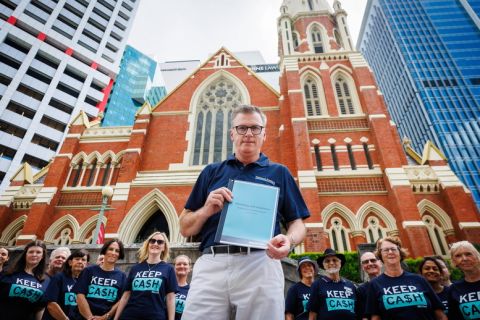Good spirit, good life
An Aboriginal-led team has developed the world’s first validated quality of life toolkit for Indigenous Elders accessing aged care.

We cannot live on bread alone as the saying goes, and that is true of people reliant on aged care as much as anyone else.
In fact, what we all want is a good life – activities and connections that sustain us emotionally, spiritually, and culturally, making us feel at home wherever we are.
But because we’re all different, the standard tools aged care providers use to assess people’s quality of life often aren’t enough to capture what is important to each individual.
This can be a particularly acute problem for Aboriginal and Torres Strait Islander people seeking care.
There is a solution though. Enter Good Spirit, Good Life, a toolkit developed to assess and inform the wellbeing of older First Nations people in ways that are culturally safe.
Good Spirit, Good Life is a world first in addressing the needs of older Aboriginal and Torres Strait Islander people.
The toolkit was co-designed by Aboriginal Elders and service providers with researchers from the Aboriginal-led Good Spirit Good Life Centre of Research Excellence based at Centre of Aboriginal Medical and Dental Health at The University of Western Australia.
The centre’s researchers, including co-directors Professor Dawn Bessarab and Dr Kate Smith, are guided by an Elders Governance Group.
Good Spirit, Good Life has since been validated for use with First Nations communities all over Australia.
It has been endorsed by the Aged Care Quality and Safety Commission and will soon be a standard part of Aged Care Assessment Teams’ tools.
Importantly, it addresses shortcomings identified by the Royal Commission into Aged Care Quality and Safety and the National Aged Care Diversity Framework. Using the toolkit will assist aged care providers to meet their quality standards, most obviously the requirements for older people to have good quality of life and cultural safety.
The Good Spirit, Good Life toolkit is easy to use, with instructions and set questions for workers to ask the person requiring care (or their support person). In addition to the assessment tool, the kit also suggests culturally relevant activities that could meet the person’s identified needs.
First Nations individuals themselves can also use Good Spirit, Good Life as a talking point with their provider to ensure they receive the care they need.
At the centre of the toolkit is a 12-point model of ‘good spirit for a good life’ specifically designed to capture what matters to older First Nations people. Uniquely, the model focuses on strengths rather than barriers, as Dr Kate Smith explained to National Seniors.
“The Elders involved were very insistent that we make a strength-based tool,” Dr Smith said. “When asking an older person, ‘What does it mean to have a good life?’, the quality of life impacts of racism and being part of the Stolen Generation were shared. However, the Elders were clear they wanted the final GSGL toolkit to focus on the connections and activities that strengthen and support a good life.
“The Elders said, for example, ‘If we are treated with respect and our community connections supported, that’s going to help heal and strengthen our spirit.’
“‘If you have a strong inner spirit,’ the Elders say, ‘then we can be healthy. We can’t be healthy without a strong spirit.’”
Good Spirit, Good Life was launched and endorsed by then Minister for Indigenous Australians, Ken Wyatt, in 2020.
It inspired the production of another aged care quality of life measurement tool, this one co-designed by and for older non-Indigenous people following the Good Spirit, Good Life protocol, called QOL-ACC. That too will be at the centre of aged care policy and process in Australia going forward.
The Good Spirit, Good Life toolkit has already had an impact internationally, with Indigenous representatives from countries such as Canada and the United States looking to adopt and adapt it to meet their Elders’ quality of life needs.
There has also been positive feedback across Australia, with aged care services saying it helped them identify gaps and organise culturally appropriate activities for their Indigenous clients.
Others say it has helped them get back to the basics of what their service is for – simply to provide older people with a good life.
For more information and to download the toolkit visit the Good Spirit, Good Life website.




